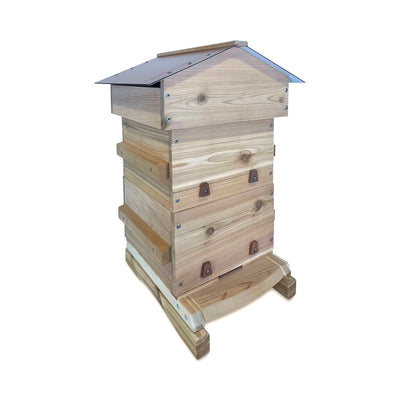Winterizing Your Bee Hive
Preparing to winterize your hive can be a daunting task, even for an experienced beekeeper.
If you’re working with Langstroth and Warre hives, you’ll want to remove surplus boxes that could potentially become dead space for cold air, which robs valuable heat from clustered bees during winter months. Also, if you’re using screened bottom boards, closing ventilation inserts will help to trap heat inside the hive. Bees expend an incredible amount of energy over the course of the winter to maintain a consistent 90-degree temperature inside of their clusters. Helping then to conserve as much energy as possible is crucial.
At the same time, it is also important to create a way for any excessive moisture to leave your hive. Because bees generate heat with the beating of their wings, that heat will rise and form condensation when it mixes with the cold air at the top of the hive. While some condensation is important — offering bees an important water source when they can’t leave the hive and offering insulation — excess moisture can become a challenge for colonies who are already struggling. However, condensation tends to get a needlessly bad rap, but as Dr. Thomas Seeley has cited, bees in natural cavities have a warm, somewhat moist environment in the winter months.
Moisture enters the hive a number of ways. Leaks in the hive roof, between rickety boxes or inadequate ventilation are potential issues to pay close attention to. When working with a Warre hive, ensure that your quilt box material is dry and lofted in order to allow for proper ventilation. If you have a Langstroth hive, you might want to consider propping the inner cover up slightly to allow for excess moisture to be released.
If you live in the extreme north and feel there may be a need to add batting to the exterior of your Langstroth or Warre hive to fend off the encroaching cold, consider wrapping your hive with tar paper or a heavy construction paper. If you’re working with a top bar hive, consider filling cavity space with straw, hay, or even an old woolen blanket to create a thermal barrier. However, be careful of over insulting. Too much insulation could block the heat of the sun. An overly warm hive could also increase bee activity, which would then increase honey consumption. David Heaf points out that the minimal use of honey stores occurs at 41 degrees Fahrenheit. “Either side of this temperature honey consumption arises.” (Heaf 83)
Having a wind barrier or wind break is also something to consider when preparing your beehives for a long winter. Bales of hay provide a nice natural way to limit the impact that icy winds can have on a hive. Be careful though! Michael Bush points out in his Practical Beekeeper series that hay bales are nothing more than “a mouse nest waiting to happen.” (Bush 421)
With all hive types; helping bees protect their stores is crucial going as move into the colder months. Mice, wasps, and even other bees can be predators looking to invade your hive. Preventative measures like mouse guards and entrance reducers can help restrict larger predators from entering the hive, as well as allow your bees to mount a formidable defense by limiting critical pathways to honey stores. Additionally, ensuring that boxes with larger stores of honey are not at ground level is also another good way of helping bees defend what they worked so hard making all spring and summer.
If you have been using a queen excluder during the spring and summer months, removing that tool is strongly encouraged during the winterizing process. Bees will migrate throughout the hive during the winter months as they continue to utilize honey stores. By removing the queen excluder, this ensures that the colony will not have to make the tough decision of following the food, or keeping the queen warm. Ultimately, it allows for more flexibility to let the bees do what they would naturally do.
Some final best practices that beekeepers should consider are periodic visual inspections throughout the course of the fall and winter months. However, avoid upsetting the hive during the winter. Opening or disturbing the hive could put a significant amount of stress on the colony, causing bees to rapidly deplete their food stores in a way they might not otherwise. A beekeeper may want to invest in a stethoscope to listen to your bees without disturbing the hive. Also, keep an eye out for signs that predators have been trying to access the hive. Lastly, pay attention to the hive entrance and make sure that the front door is not blocked by dead bees or debris, restricting access to vitally important airflow.






Leave a comment